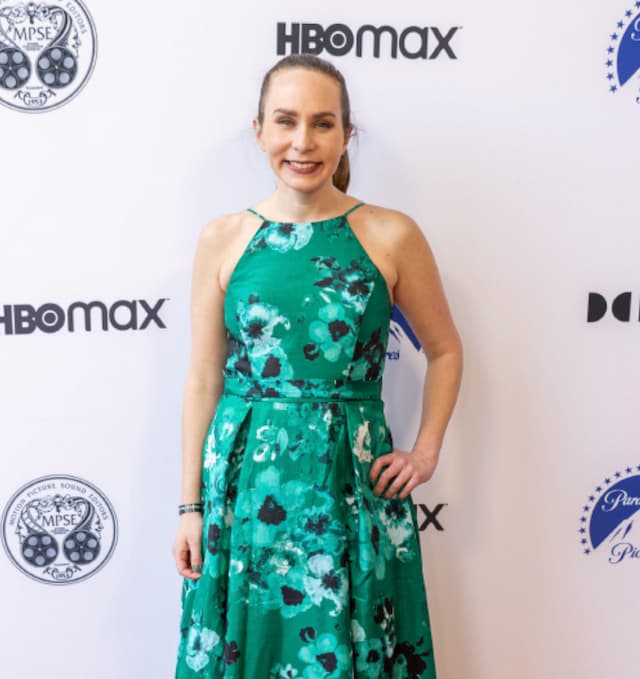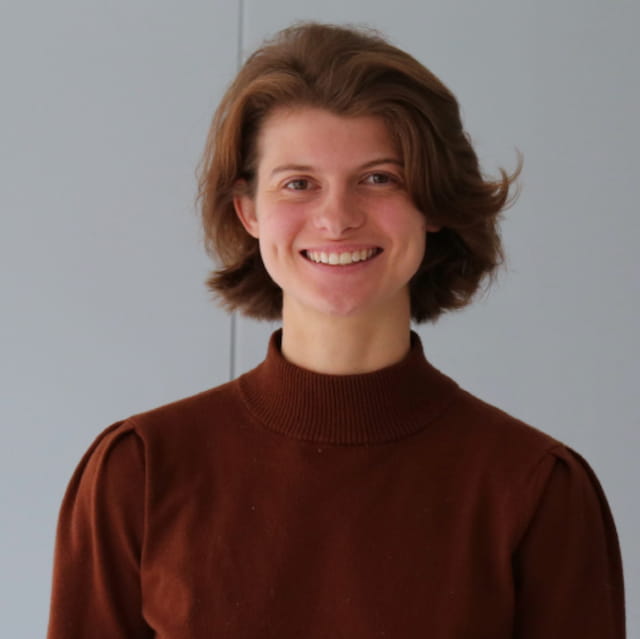Hitting the Right Notes: AU Audio Tech Alums Making Their Mark on Industry
American University’s MA in audio technology focuses on both the art and the science of music technology to prepare students for a wide variety of careers in the industry. During their studies, students explore audio disciplines that interest them the most, such as music production, sound design, software creation, and acoustic design in a nurturing environment with nationally recognized faculty.
Connor Lammas (MA audio tech ’25) recently checked in on just a few audio tech alumni for a piece he contributed to the department’s newsletter—read on as he shares their stories here!
Rebeca Lindenfeld

Rebeca Lindenfeld (BA, audio technology ’17, MA, audio technology ’18) is working in New York City for the post-production studio Parabolic, doing dialogue editing and ADR (Automated Dialogue Replacement) for the studio’s major clients. With her former company Deluxe Spain, and now Parabolic, Lindenfeld has worked on projects for major clients, such as Veneno on HBO Max, the MXN Entertainment film Lisa Frankenstein, and The Mess You Leave Behind on Netflix, which was recently nominated in Galicia for a Mestre Mateo Award.
A self-proclaimed perfectionist, Lindenfeld notes that precision helps with dialogue editing in her work. In ADR work, one must pay attention to every noise that does not have to be in the dialogue, including mouth clicks, clarity of annunciation, and correctness of pronunciation.
Aside from her “perfectionist” tendencies, Lindenfeld has a collaborative spirit and regularly seeks input and guidance. Hailing from Venezuela, she explains that an often-overlooked challenge for international ADR workers is differences in dialect, such as how Spanish in Spain is a challenge because she occasionally can’t understand the pronunciation. Occasionally in post-production, Lindenfeld would insist that a particular piece of dialogue be rerecorded only to find that Spanish speakers in Spain understood the original take. When necessary, she asks native speakers how comprehensible or natural the pronunciation is to tailor her work to the target audience.
Lindenfeld first entered AU’s Audio Tech Program as a physics minor with a passion for sound and an interest in the intersectionality between the two. During her time in the program, she learned about audio engineering and the science of sound. She believes her coursework in critical listening, ProTools, and fundamentals of sound design was essential to her career trajectory and current success. Her knack for adaptation, collaboration, and precision all contribute to her success as an international editor working on projects worldwide.

Jonathan Cornell
Before he started mixing or studying sound, Jonathan Cornell (MA, audio technology ’23) would participate in discussions on music forums and study records he acquired to learn the basics of audio engineering. Cornell now works for Immersive Audio Album (IAA), a subsidiary of Deviant Labs.
At IAA, Cornell works with the company to expand its growing downloadable catalog of albums mixed in the increasingly popular Dolby Atmos format. His role shifts between multiple facets of the music industry, including A&R, music journalism, data management, and audio engineering. With Immersive Audio, Cornell credits some of his success to his unique consumer-oriented background as he helps the company grow and evolve. He often meets with label representatives to discuss licensing and other forms of collaboration. During his tenure, IAA has successfully initiated partnerships with labels including Snapper Music in the UK, Alma Records in Canada, and Evolution Music Group in Hong Kong. He also frequently conducts interviews with artists and engineers who’ve embraced the immersive format.
One interview was with British singer-songwriter Steven Wilson, who has developed a reputation in the music industry as one of the premier Dolby Atmos mixers with his mixes of classic records such as The Who’s Who’s Next (1971), The Grateful Dead’s American Beauty (1970), and Tears for Fears’ The Hurting (1983). Following the interview, Wilson would send Cornell some of his latest Atmos mixes for feedback, often considering his ideas and suggestions for future revisions. Cornell received a mention in the credits of Wilson’s September 2023 album The Harmony Codex.
During his time at American University, Cornell took a liking to the technical aspects of mixing and engineering, which he believes gave him the knowledge and language to succeed as an audio journalist. “Learning proper mixing workflow in class was so critical, as it helps me interface with these professionals in the industry during email exchanges and interviews,” he says. “Once they hear me asking about concepts like mix bus compression, stems, or send/return channels, they know I’m speaking their language.”

Liz Grzyb
Since completing her degree, Liz Grzyb (BS, audio technology ’19) has been working for architectural engineering firm ARUP as part of its acoustic, audiovisual, theater, and experience design team, specializing as an acoustics and audiovisual consultant. As part of her work, Grzyb deals in the physics of sound design—working with acoustics for building interiors, noise isolation from a building’s surroundings, and soundproofing rooms, among other tasks.
In her field, Grzyb finds daily intersection between her minor in applied physics, her concentration in computer science, and her degree in audio technology when running simulations with acoustics modeling software like CATT Acoustics and EASE. When running sophisticated simulations, Grzyb can predict how rooms might sound once construction is finalized and how alterations of the architecture will change that sound. While the accuracy of models varies, Grzyb finds that, “it comes down to how much information you have when building the model. If you’re working on a preexisting structure, you may not know what materials were used because the construction documents may have been lost or not kept.”
Regularly tackling several projects at a time, Liz Grzyb’s career is far from static. Grzyb is working on a new office skyscraper in New York containing a diverse collection of tenants. The space includes offices, retail spaces, and a restaurant, giving the skyscraper a unique combination of different sonic profiles. Beyond office building design, Grzyb’s portfolio contains work in library acoustics, event spaces, automotive showrooms, performance spaces, and podcasting. In her experience, Grzyb finds it’s common to simultaneously work on multiple projects. If given a choice, she loves to work in recording studios due to her passion for audio design and the opportunity to apply her audio engineering degree. Daily, Grzyb applies concepts she learned in the Audio Technology Program, like RT60, for reverberation time and familiarity with how paneling in a studio affects sound. Overall, Grzyb’s skillset is tailored to audio-visual (AV) design.
